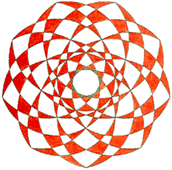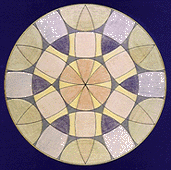|

|
Remo
F. Roth
Dr.
oec. publ., Ph.D.
dipl.
analyt. Psychologe (M.-L. v. Franz)
|

|
© copyright 2002 by
Pro Litteris, Zürich. All rights reserved
Urheberrechtsverletzungen
werden international verfolgt. Genehmigungen zur Publikation von
Zitaten durch den Autor über email
With many thanks
to Gregory Sova, Ph.D. (LA, CA) and Phyllis Luthi (CA) for the
help with the translation
back
to part 1
Wolfgang Pauli and
Parapsychology
(part 2)
(Extended English version of the German
article)
2. Wolfgang Pauli's dispute with
Marie-Louise von Franz and the inclusion of the psychoid archetype
into physics
We must now ask ourselves, what specific
dream symbols could have caused the transformation process in Pauli's
mind? Namely, if we could translate them into a rational language,
today, almost 70 years after the appearance of this symbolism in his
soul, we would have already approached a much better comprehension of
the connection between quantum physics and parapsychology. At the
beginning of the 21st century, such an insight becomes
more and more necessary because of the large increase in UFO
sightings, which we are likely to understand only with the help of
such a connection.
To do this work, we must distinguish between
two different facts: We must ask how Pauli himself interpreted his
dream symbols, but as important as this are the original roots for
such an interpretation, the dreams and imaginations themselves, which
had not yet been treated by his consciousness. Unfortunately we are
still missing the above-mentioned dreams and imaginations from the
years 1934 and 1935, but the hitherto published material - especially
the letters from the years 1952, 1953 and 1954 to Marie-Louise
von Franz, Aniela Jaffé and
Carl G. Jung - allow us to draw some important
conclusions.
To understand Pauli's conscious insights,
distilled from "incubating" his dreams in Active Imagination
for the purpose of the reunion of physics and parapsychology, we must
extend our research. In 1953 he confronted Jung in the context of the
above-quoted Einstein dream with the idea of integrating his
psychology - which "like an illegitimate child of the spirit, leads
to an esoteric, special existence beyond the fringe of what is
generally acknowledged to be the academic world" - into physics. He
writes, that
"there is a flowing of
psychological contents into physics and mathematics, and ... this
has to continue until psychology can be adopted by physics
(possibly together with biology)"
and
"What springs to mind ...
here as a model is chemistry, for example, which can already be
said to have basically been adopted by physics"
After a long interval of five months - during
which time he retreated from the battle field, leaving
it to Marie-Louise
von Franz (see below) - Jung replied to this occupation of his depth
psychological results, empirically and independently found from
physics, that
"there cannot be just
one way of access to the secret of Being; there must be at
least two - namely, the material occurrence on the one hand
and the psychic reflection of it on the other (although it will be
hard to determine what is reflecting what!)."
Since Pauli had the habit of discussing the
arguments, stated in the letters to Jung, also with his close
collaborators Marie-Louise von Franz and Aniela Jaffé in oral
and written form, we possess valuable historical references to the
dramatic occurrences of that time.
These letters show that Pauli, with this idea
of occupation, produced violent outbursts of rage in
Marie-Louise von Franz. This is why he gives her the advice, better
to invest the energy caught in her rage into the interpretation of
his dreams - especially into the motif of the idiot, projected onto
his friend, the psychiatrist Carl A. Meier [RFR: who became later
the editor of the Pauli/Jung letters (1992; Engl. ed: Atom and Archetype,
2001)]. Even before he
wrote to her:
"The
problem - which I hold for unresolved despite your authoritarian
and passionate explanations about that what I 'do not understand'
- is the proper definition of terms with suitable
extent..."*)
As the author himself knows, such outbursts
of rage exhibited by the Jung's most important student about
heretical declinations of the master's dogma often effected the Anima
of the afflicted person to react with a superb creative performance.
Instead of turning away from his partner, Pauli interpreted such
fierce discussions to be like an intellectual competition in a Talmud school that would have induced him to reflect upon his idea of
occupation.
Two and a half months after this
confrontation with Marie-Louise von Franz and with his power shadow,
Wolfgang Pauli had solved the problem of "the proper definition of
terms with suitable extent." He writes in the letter, which contains
also his today famous Klavierstunde (The Piano Lesson)
dedicated to her: "In principle I do not see any further
reason to assume that psychology will ever be merged with a
generalized physics"*)
. Moreover he sees the power behind
his earlier statement: "The demand of totality is anyhow
suspicious."*)
And then he writes:
"To explain the physical
symbolism of my dreams, a less far-reaching assumption is sufficient. Namely, the tendency of my dreams is to assimilate
into physics, all that ... is considered the 'psychoid archetype'.
In other words: "Parapsychology and biology should be
included in an expanded physics." *)
But it was not only conscious reflection that
had led Pauli to this conclusion. After the fight with his
psychological counterpart he had - as he describes too in the letter
- several dreams which tried to correct his one-sided conscious
attitude. In one of them Niels Bohr told him "to give the woman more
money"*).
With "Bohr" he associated "symmetrical treatment of the pairs of opposites,"*),
with "woman" "the conscious-transcendent unity beyond the pair
physics-psychology"*).
With these associations he was able to translate the expression "to
give the woman more money" by "Bohr" into a new realization that he
obviously did not comprehend the pair physics-psychology
symmetrically enough. In this manner he was prepared to open his mind
for the above-mentioned idea of including the psychoid archetype (or the
psychophysical archetype), and by this the inclusion of parapsychology and
biology instead of depth psychology into physics.
Thus, the dialectical process of the dispute
with Marie-Louise
von Franz on the one hand and the
dreams, reacting to this battle on the other effected that Pauli was
now ready to advance to the synthesis of giving up the occupation
desire concerning Jung's psychology and transforming the unconscious
claim of his power shadow into a conscious realization. In my opinion
exactly this psychic faculty makes him one of the greatest and
ethically most responsible scientists of the 20th
century.
It will be the challenge of the generation of
scientists at the beginning 21st century, to remember this
achievement of Pauli and ask themselves, how they can - helped by
"incubating" their dreams and with imaginative techniques - diminish
their power complex first for the purpose of improving their
knowledge and second, to allow it to be influenced as little as
possible by unconscious prejudices. Such a non-prejudiced focus would
be very much necessary to overcome their fantasies of omnipotence. Only then one
has the necessary condition for the
acceptance and further exploration of the UFO-phenomenon, because
exactly the insight in our powerlessness and helplessness concerning
these phenomena is required to understand the connection of these
physical anomalies with the empirically investigatable processes in
the deepest depths of the the realm behind the collective psyche
(which is the unus mundus; see below).
*) All quotations from [Pauli,
1999] translated by Remo F. Roth with the help of Phyllis
Luthi
proofread by GJS, 12/24/2003
Meier, C.A., (ed.), Atom and
Archetype, The Pauli/Jung Letters 1932-1958, Princeton University
Press, New Jersey, 2001
Pauli, Wolfgang,
Wissenschaftlicher Briefwechsel mit Bohr, Einstein, Heisenberg,
u.a, ed. Karl v. Meyenn, vol. 4/II, Springer, Berlin,
1999
part
3
See also further articles about Wolfgang Pauli in
http://www.psychovision.ch/rfr/roth_e.htm
Homepage
Remo F. Roth
back

12..8.2002
|